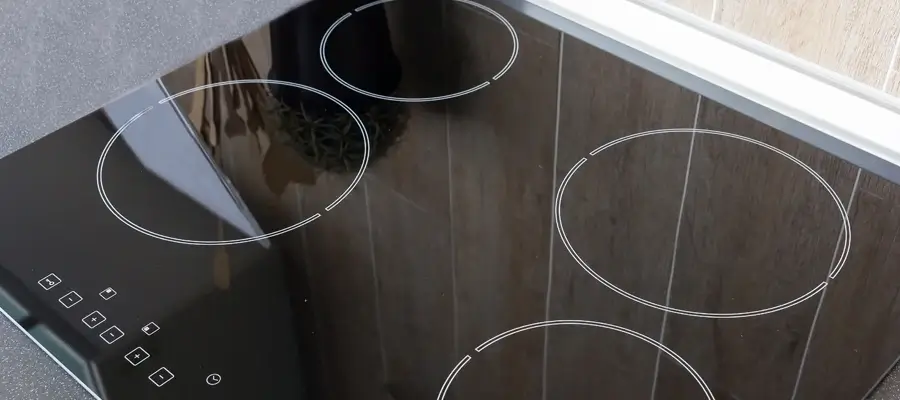Ceramic vs Electric Coil Stove Cooktops: What Are the Differences?

When shopping for an electric range, a buyer’s most impactful decision is cooktop type. Not brand.
Certainly not color.
Not even appliance size or the number of available burners.
Most ranges use traditional coil technology or a smooth, glass-ceramic surface for stovetop heating. Each cooktop type holds advantages and disadvantages.
Understanding the differences can help you make the right decision for your budget and lifestyle.
A third stove technology involves electromagnetic induction, which works only with pots and pans with ferromagnetic bottoms. Electromagnetic stoves are much less common than coil and ceramic stoves. For the sake of clarity and brevity, we’re leaving them out of this discussion.
Coil Cooktops: How They Work
Commonly called rings or burners, coils are fashioned from spiral steel tubes housing a heating element. Anything placed on these coils is heated directly. Stove dials control temperature by adjusting the resistance levels in the heating element — more resistance means higher heat.
Coil temperatures rise and fall according to dial settings — not instantaneously, as with gas, but with a time lag.
Ceramic Cooktops: How They Work
Ceramic cooktops are made from toughened, non-expansive glass that allows heat or infrared radiation to pass through efficiently with little dissipation. The flat surface of a ceramic cooktop offers a few practical and aesthetic advantages over its conventional coil cousin.
Ceramic Vs Coil Stove: Key Comparisons
Price
The first electric stove used platinum wire coils and was patented in 1896. Not much has changed since then — coil stoves today work essentially the same way they did a century ago, albeit with better materials and power sources.
They remain the easiest and cheapest electric stoves to produce and require no space-age components.
So there you have it: the biggest benefit of a coil cooktop. It’s cheaper! More efficient ceramic stoves occupy the premium end of the market and command a higher price tag.
Heat
Ceramic stove tops hold the edge over coils, producing heat faster, though nowhere close to the instantaneous heat of gas.
- When it comes to cooling down, ceramic tops have a decided edge over coils.
- Heat passes through a ceramic surface. It’s not transmitted by the ceramic, unlike a metal coil which carries heat directly to cooking pans and stays hot longer when turned off.
- Heat under a ceramic plate is more focused. A smaller area is heated; other parts of the cooktop stay cool.
- In short, metal coils present a greater burn risk. When water’s boiling furiously in the pot or heating elements are glowing red, it’s obvious enough that coils shouldn’t be touched.
But a metal coil can retain enough heat to burn skin for several minutes after use, at which point there’s no visual clue of danger.
Cleaning
- Electric coil stovetops can be a chore to clean. There’s no other way to put it.
- Drip bowls have to be removed and washed in soapy water.
- The steel plate under drip bowls tends to collect grease.
- Enamel or steel stovetops should be wiped down after every use.
- With all their nooks and crannies, coil stoves are gunk magnets.
- Cleanup for ceramic stovetops involves a soft cloth and special ceramic cleaner (do not use harsh abrasives).
As with coil stoves, you should wipe down a ceramic stovetop after every use to prevent spills from baking in and permanently marring the surface.
Durability
Here, coil stovetops are the clear winner. They can handle any pot or pan you place on them, including cast iron. Equally important, damaged coils and drip bowls are so simple to replace that anyone can manage the DIY repair.
- Ceramic surfaces are more vulnerable to scratching. Even some grocery bags can damage a ceramic stovetop.
- Avoid heavy or abrasive cookware like cast iron.
- Never place anything other than a pot, pan, or kettle on a ceramic stove.
- Make sure that cooking hardware is light and smooth.
Appearance
Aesthetics are often cited as the number one reason for choosing glass-ceramic stovetops over coils. Burners are hidden from view, giving ceramic stovetops a sleek, modern look compared to utilitarian electric coil counterparts.
A brand new glass-ceramic surface will always win the stovetop beauty pageant. Like all beauty, it will quickly fade if abused. Choose ceramic if:
- You care about kitchen style;
- You’re willing to pay extra for it;
- You’re willing to care for a surface that scratches more easily.
Choose coils if:
- You want something cheaper.
- You’re looking for a stove that can withstand neglect and abuse and is easy to repair.
Call West Coast Chief Repair for Help
Questions? Contact West Coast Chief repair for appliance recommendations, new appliance installation, and old appliance repair.
We also sell trusted brands of electric ranges and other appliances.
We offer financing and honor manufacturer warranties. If your coil or ceramic stovetop has reached the end of its life, you may want to talk to us first.
Related Appliance Pages
More Articles
0 Comments
Trackbacks/Pingbacks